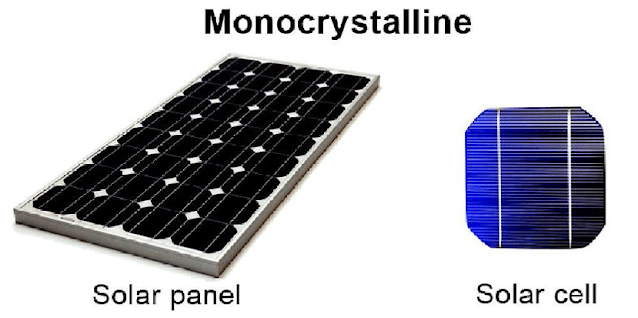Monocrystalline Solar Panels (Mono-Si)
Monocrystalline solar panels, often recognized for their
sleek black appearance, are among the most popular and efficient options in
solar energy technology. These panels are made from a single, pure silicon
crystal, which gives them their unique properties and high performance. Let’s
delve deeper into their features, advantages, and applications to understand
why they are a top choice in renewable energy solutions.
What Are Monocrystalline Solar Panels?
Monocrystalline solar panels are constructed using silicon
wafers derived from a single silicon crystal. This single-crystal structure
allows for a uniform arrangement of molecules, enhancing the panel's ability to
convert sunlight into electricity. During manufacturing, silicon is melted and
shaped into cylindrical rods, which are then sliced into thin wafers.
The resulting panels have a uniform dark appearance with
rounded edges due to the cylindrical shaping process.
Key Features
High Efficiency:
Monocrystalline panels are known for their efficiency,
ranging between 15-22%.
They perform exceptionally well even in low-light
conditions.
Long Lifespan:
With a lifespan of over 25 years, these panels offer
long-term reliability.
Manufacturers often provide extensive warranties, reflecting
their durability.
Compact Design:
Their high efficiency allows for smaller panel sizes
compared to other types, making them ideal for space-constrained installations.
Advantages of Monocrystalline Solar Panels
Superior Performance:
Monocrystalline panels convert more sunlight into
electricity compared to polycrystalline and thin-film options. This makes them
highly effective in maximizing energy output.
Durability:
They are designed to withstand harsh environmental
conditions, including high temperatures and strong winds.
Aesthetic Appeal:
The uniform black surface provides a modern, sleek look that
many homeowners prefer.
Temperature Tolerance:
These panels maintain good performance even in
high-temperature environments, making them suitable for various climates.
Disadvantages to Consider
Higher Cost:
The complex manufacturing process contributes to their
higher price point.
However, their efficiency and longevity often offset the
initial investment over time.
Waste During Production:
The cylindrical shaping process leads to some silicon
wastage, making production less eco-friendly compared to other panel types.
Applications
Monocrystalline solar panels are versatile and can be used
in various applications, including:
Residential Solar Systems: Ideal for homeowners looking for
efficient, space-saving solutions.
Commercial Projects: Commonly used in businesses and
industrial facilities to reduce energy costs.
Solar Farms: Their high efficiency makes them suitable for
large-scale energy production.
Conclusion
Monocrystalline solar panels are a top-tier choice for
anyone seeking efficient and reliable solar energy solutions. While their
initial cost may be higher than other panel types, their long-term performance,
durability, and space-saving benefits make them a worthwhile investment. As the
world continues to transition toward renewable energy, monocrystalline panels
remain a cornerstone in the journey to sustainable living.
Whether you're installing a rooftop system or powering a
large-scale project, monocrystalline panels provide an efficient and dependable
solution for harnessing the power of the sun.

Comments
Post a Comment